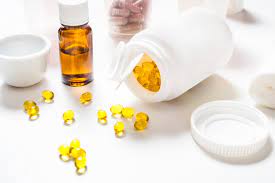
Vitamin D is a necessary mineral that helps the body regulate calcium and phosphorus levels, strengthens the immune system, and maintains bone health. As vital as it is to obtain enough vitamin D, limiting consumption is just as necessary, as this can result in toxicity and negative health repercussions. This page discusses safe vitamin D dosage recommendations, variables affecting personal needs, and methods for guaranteeing ideal vitamin D levels.
Understanding Vitamin D
There are two primary types of vitamin D: D2 (ergocalciferol) and D3 (cholecalciferol). When exposed to Vitamin D3, it is created by the skin and can also be found in some foods and supplements. Fortified foods and plant sources are the usual sources of vitamin D2. While either form can raise blood levels of vitamin D, vitamin D3 is thought to have a greater potency and longer half-life.
Recommended Daily Allowance (RDA)
The amount of vitamin D recommended daily (RDA) varies according to age, gender, and stage of life. The Institute of Medicine (IOM) established these recommendations, which are intended to satisfy the requirements of 97-98% of healthy people:
- 0–12-month-olds: 400 International Units (IU) every day
- Children (ages 1 to 18): 600 IU daily
- For adults (19–70 years old), 600 IU daily
- Adults (71 years of age and up): 800 IU daily
- Women who are nursing or pregnant: 600 IU daily
Factors Influencing Vitamin D Requirements
An individual’s need for vitamin D can be influenced by several factors, including:
Sun Exposure
Sunlight exposure causes the skin to create vitamin D3. Various factors, including skin pigmentation, time of day, season, geographic location, and sunscreen, can influence vitamin D synthesis from sunshine.
Nutrition
Egg yolks, fortified dairy products, and fatty fish (including salmon, mackerel, and sardines) are some foods high in vitamin D. Supplemental vitamin D may be necessary for those deficient in specific sources.
Age
Older people are more likely to be vitamin D deficient because their skin produces less vitamin D, they consume less food, and they spend less time outside.
Health Conditions
Osteoporosis, malabsorption syndromes (such as Crohn’s disease and celiac disease), and chronic renal or liver illnesses are a few medical problems that might alter vitamin D metabolism and raise the need for supplements.
Secure upper limits
Even though vitamin D is necessary for good health, taking too much of it can be harmful and cause hypercalcemia or elevated blood calcium levels. To avoid adverse effects, the IOM has set acceptable upper intake levels (ULs):
- Young children (0–6 months): 1,000 IU daily
- Young children (7–12 months): 1,500 IU daily
- Children (ages 1-3): 2,500 IU daily
- For children (4–8 years old), 3,000 IU daily
- 4,000 IU daily for children and adults (9 years and older).
These ULs aim to shield the general public from the risk of toxicity. However, under medical supervision, healthcare practitioners may prescribe greater doses to select individuals with specific medical issues or low baseline levels.
Monitoring Vitamin D Levels
People taking supplements or at risk of vitamin D insufficiency should have their blood levels of 25-hydroxyvitamin D tested frequently to guarantee adequate levels. Most people agree that the ideal range is between 30 and 50 ng/mL. Levels under 20 ng/mL indicate a deficit, while levels above 50 ng/mL may indicate possible toxicity.
Advice on Taking Vitamin D Supplements Safely
- Speak with a Healthcare Professional: See a healthcare professional before beginning any supplement regimen to determine your correct dosage and requirements.
- Select High-Quality medication: Choose vitamin D pills of the highest caliber from reliable producers to guarantee purity and efficacy.
- Prevent Megadoses: Adhere to the suggested amounts and abstain from consuming high-dose supplements unless a doctor has approved them.
- Combine with Calcium: Consume enough calcium to maintain bone health and optimize the advantages of vitamin D.
FAqs
Is daylight sufficient to provide me with enough vitamin D?
Several variables influence sunlight-induced vitamin D production, including skin pigmentation, latitude, season, and time of day. Even while sunlight is a naturally occurring source of vitamin D, not everyone will get enough of it, particularly in areas with little sunlight or winter.
Is there a risk involved in consuming too much vitamin D?
A high vitamin D intake can indeed produce toxicity, which can manifest as weakness, nausea, vomiting, and kidney issues. Although individual tolerance can vary, the safe upper limit for daily intake is usually thought to be 4,000 IU for most adults.
Who is susceptible to a lack of vitamin D?
People who have a dark complexion, little sun exposure, age, certain medical illnesses (such as malabsorption disorders), and veganism are among those who are more likely to suffer from a vitamin D deficit.
Do I need to take vitamin D supplements?
Supplements could be suggested if your diet and exposure to sunshine are insufficient to provide you with enough vitamin D. It is best to speak with a healthcare professional to determine the right dosage given your unique demands and current state of health.
Summary
Although vitamin D is necessary for maintaining general health, it is important to follow recommended dosage amounts to avoid toxicity. You can attain ideal vitamin D levels and take advantage of the related health benefits by being aware of your specific needs, monitoring your blood levels, and speaking with medical professionals.







